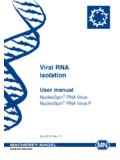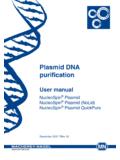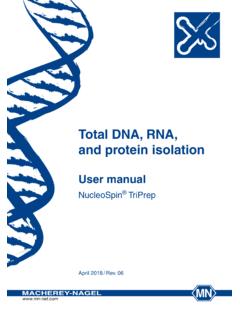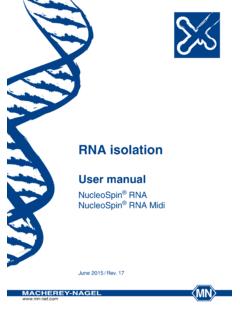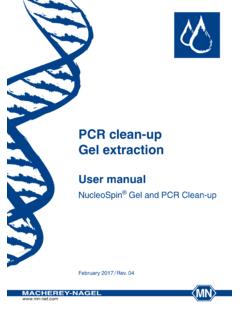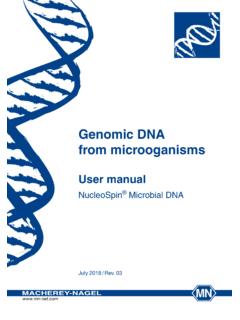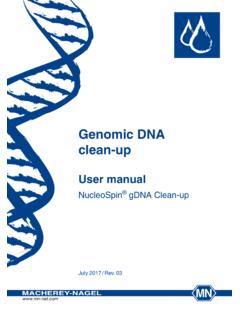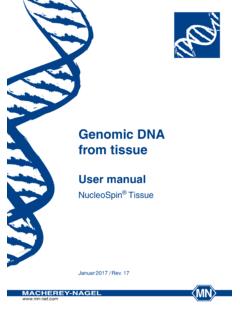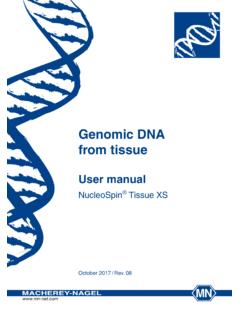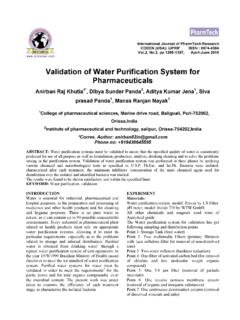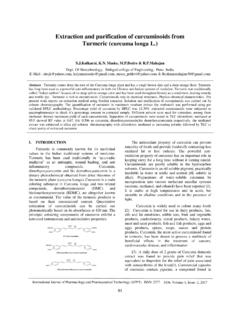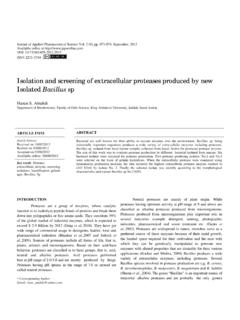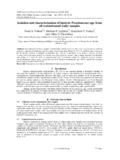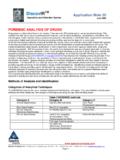Transcription of Genomic DNA from food - mn-net.com
1 US:Tel.: +1 484 821 0984 Fax: +1 484 821 1272 E-mail: GmbH & Co. KG Neumann-Neander-Str. 6 8 52355 D ren / International:Tel.: +49 24 21 969-0 Fax: +49 24 21 969-199 E-mail: +41 62 388 55 00 Fax: +41 62 388 55 05 E-mail: +33 388 68 22 68 Fax: +33 388 51 76 88 E-mail: GmbH & Co. KG Neumann-Neander-Str. 6 8 52355 D ren / International:Tel.: +49 24 21 969-0 Fax: +49 24 21 969-199 E-Mail: +41 62 388 55 00 Fax: +41 62 388 55 05 E-Mail: +33 388 68 22 68 Fax: +33 388 51 76 88 E-Mail: ISO 9001 ZERTIFIZIERTMACHEREY-NAGEL GmbH & Co. KG Neumann-Neander-Str. 6 8 52355 D ren / International:Tel.: +49 24 21 969-0 Fax: +49 24 21 969-199 E-Mail: +41 62 388 55 00 Fax: +41 62 388 55 05 E-Mail: +33 388 68 22 68 Fax: +33 388 51 76 88 E-Mail: ISO 9001 ZERTIFIZIERTG enomic DNA from foodUser manualNucleoSpin FoodMarch 2017 / Rev.
2 12 Contact MNGermany and internationalMACHEREY-NAGEL GmbH & Co. KGNeumann-Neander-Str. 6 8 52355 D ren GermanyTel.: +49 24 21 969-0 Toll-free: 0800 26 16 000 (Germany only)Fax: +49 24 21 969-199E-mail: Support BioanalysisTel.: +49 24 21 969-270E-mail: Emrick Blvd. Bethlehem, PA 18020 USATel.: +1 484 821 0984 Toll-free: 888 321 6224 (MACH)Fax: +1 484 821 1272E-mail: SARL associ unique1, rue Gutenberg 67722 Hoerdt FranceTel.: +33 388 68 22 68 Fax: +33 388 51 76 88E-mail: AGHirsackerstr. 7 4702 Oensingen SwitzerlandTel.: +41 62 388 55 00 Fax: +41 62 388 55 05E-mail: 03/2017, Rev. 12 Genomic DNA from foodTable of contents1 Components Kit contents Reagents, consumables, and equipment to be supplied by user About this user manual 52 Product description The basic principle Kit specifications Storage and homogenization of samples Methods to homogenize samples Elution procedures 83 Storage conditions and preparation of working solutions 94 Safety instructions 105 General remarks Important information and advice 126 Protocol for Genomic DNA purification from food 137 Appendix Troubleshooting Ordering information Product use restriction / warranty 17 MACHEREY-NAGEL 03/2017, Rev.
3 124 Genomic DNA from food1 Components Kit contentsNucleoSpin FoodREF10 preps preps preps Buffer CF12 mL100 mL300 mLBuffer C410 mL30 mL150 mLWash Buffer CQW6 mL30 mL125 mLWash Buffer C5 (Concentrate)*6 mL12 mL50 mLElution Buffer CE**13 mL13 mL60 mLNucleoSpin food Columns (plus Collection Tubes)1050250 Proteinase K (lyophilized)* mg6 mg30 mgProteinase Buffer mL8 mLCollection Tubes (2 mL)1050250 User manual111* For preparation of working solutions and storage conditions see section 3.** Composition of Elution Buffer CE: 5 mM Tris/HCl, pH 03/2017, Rev. 12 Genomic DNA from Reagents, consumables, and equipment to be supplied by userReagents 96 100 % ethanolConsumables mL microcentrifuge tubes for sample lysis and DNA elution Disposable pipette tipsEquipment Manual pipettors Centrifuge for microcentrifuge tubes Vortex mixer Heating-block for incubation at 65 C Incubator or water bath for preheating Lysis Buffer CF (to 65 C) and Elution Buffer CE (to 70 C) Equipment for sample disruption and homogenization (see section ) Personal protection equipment (lab coat, gloves, goggles) About this user manualIt is strongly recommended reading the detailed protocol sections of this user manual if the NucleoSpin food kit is used for the first time.
4 Experienced users, however, may refer to the Protocol-at-a-glance instead. The Protocol-at-a-glance is designed to be used only as a supplemental tool for quick referencing while performing the purification procedure. All technical literature is available on the internet at Please contact Technical Service regarding information about changes of the current user manual compared to previous 03/2017, Rev. 126 Genomic DNA from food2 Product descriptionNucleoSpin isolation technology from MACHEREY-NAGEL GmbH, and GMO experience from GEN-IAL GmbH were combined to provide an optimal lysis and purification system for nearly all types of food samples. Resulting eluates are ready-to-use for all types of subsequent detection methods, especially for real-time and basic PCR is an established startup company, which offers contract research and molecular testing services in food and feed stuff.
5 Special areas of interest are the development and standardization of detection methods for GMOs, as well as animal and microbial species identification and silica-membrane technology from MACHEREY-NAGEL allows fast and effective purification of nucleic acids from various matrices. The silica membranes are optimized for high DNA recovery and low binding efficiency for impurities. The basic principleAfter the food samples have been homogenized, the DNA can be extracted with lysis buffers containing chaotropic salts, denaturing agents, and detergents. The standard isolation ensures lysis using Lysis Buffer CF, which was especially developed by GEN-IAL for food matrices (patent pending). Lysis mixtures should be cleared by centrifugation or filtration in order to remove contaminants and residual cellular debris.
6 The clear supernatant is then mixed with binding buffer and ethanol to create conditions for optimal binding to the NucleoSpin silica membrane, which was selected for this purpose due to its unique DNA-binding properties. After washing with two different buffers for efficient removal of potential PCR inhibitors, DNA can be eluted in low salt buffer or water (see section for details), and is ready-to-use for subsequent reactions. food samples are very heterogeneous and contain many different compounds like fat, cocoa, or polysaccharides, which can lead to suboptimal extraction or subsequent processing of DNA. NucleoSpin food guarantees good recovery for small Genomic DNA fragments (< 1 kbp) out of processed, complex food matrices ( , ketchup or spices), which generally have very low DNA contents, as well as poor quality, degraded DNA.
7 Because of this, we recommend the selection of primers, which amplify only short DNA fragments (80 150 bp).7 MACHEREY-NAGEL 03/2017, Rev. 12 Genomic DNA from Kit specifications NucleoSpin food is designed for isolation of Genomic DNA from food samples preferably of plant or animal origin. However, bacteria can also be processed (see section for details). The NucleoSpin food kit can be used for the identification of GMO-DNA or animal components in food and feed. NucleoSpin food standard procedure allows processing of up to 200 mg material. Depending on the individual sample, typical yields for NucleoSpin food are in the range of 10 g DNA. The eluted DNA is ready-to-use for subsequent reactions like real-time PCR, GMO detection, 1: Kit specifications at a glanceParameterNucleoSpin FoodFormatMini spin columnSample material5 200 mgFragment size300 bp approx.
8 50 kbpTypical 10 gA260 volume100 LPreparation time30 min/6 prepsBinding capacity30 Storage and homogenization of samples The lysis procedure is most effective when well homogenized, powdered samples are used. To achieve this, we recommend grinding with a pestle and mortar in the presence of liquid nitrogen or using steel beads. Commercial homogenizers can also be used. After homogenization and treatment of the sample with lysis buffer, mixtures can be cleared easily and effectively by either centrifugation or with NucleoSpin Filters (see ordering information).MACHEREY-NAGEL 03/2017, Rev. 128 Genomic DNA from Methods to homogenize samples Pestle and mortar in the presence of liquid nitrogen Commercial homogenizers, for example bead mills VA steel beads (diameter: 7 mm, sample available on request): Put 4 5 beads and food material together in a 15 mL plastic tube (Falcon), chill the tube in liquid nitrogen.
9 Vortex for about 30 s ( , with a Multi Pulse Vortexer, contact Sch tt Labortechnik GmbH, Postfach 3454, D-37024 G ttingen, Germany). Repeat this chilling and vortexing procedure until the entire sample is ground to a powder. Chill the tube once more and remove the beads by rolling them out gently or by using a magnet. Keep the material frozen throughout the whole homogenization procedure. Do not add nitrogen to the tube! This leads to sticking and loss of sample as it attaches to the Elution proceduresIt is possible to adapt the elution method and volume of elution buffer for the subsequent application of interest: Complete yields: By performing two elution steps with 2 x 100 L, 90 100 % of bound nucleic acids can be eluted. Finally, combine eluates and measure yield.
10 Highly concentrated eluates: With minimal elution volumes (25 50 L) about 60 80 % of bound nucleic acids can be eluted, resulting in highly concentrated Buffer CE (5 mM Tris/HCl, pH ) can be replaced by TE buffer or water as well. If water is used, the pH should be checked and adjusted to pH 8 since deionized water usually exhibits a pH below 7. Furthermore, absorption of CO2 leads to a decrease in pH of unbuffered 03/2017, Rev. 12 Genomic DNA from food3 Storage conditions and preparation of working solutionsAttention: Buffers C4 and CQW contain guanidine hydrochloride and detergents! Wear gloves and goggles!CAUTION: Buffers C4 and CQW contain guanidine hydrochloride which can form highly reactive compounds when combined with bleach (sodium hypochlorite).
